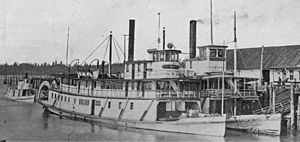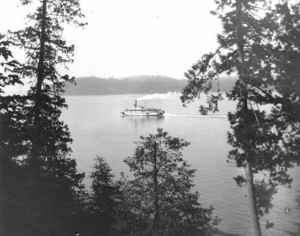Multnomah (sternwheeler) facts for kids

Multnomah at dock at Three Tree Point, circa 1910
|
|
Quick facts for kids History |
|
|---|---|
| Name | Multnomah |
| Port of registry | |
| Launched | 1885 |
| In service | 1885-1911 |
| Fate | Sunk following collision, 1911 |
| General characteristics | |
| Type | Sternwheel passenger/freight/towboat |
| Length | 143 ft (43.6 m) |
The Multnomah was a special kind of boat called a sternwheeler. It was built in East Portland, Oregon, in 1885. This boat worked on the Willamette and Columbia Rivers in the United States. Later, it moved to Puget Sound and became a very famous steamboat there.
Building the Multnomah
The Multnomah was built to travel between Portland and Oregon City. At that time, it was seen as one of the best boats on the Willamette River. An early captain of the Multnomah was James D. Miller. He was in charge of the boat from 1830 to 1914.
Moving to Puget Sound
In 1889, the Multnomah moved to Puget Sound. The S. Willey Navigation Company owned it then. The boat made regular trips from Olympia to different places on Puget Sound.
In 1900, Captain H.H. McDonald bought the Multnomah. He also bought another boat called Capital City. Captain McDonald wanted to compete with another steamboat, the Greyhound. The owners of Greyhound eventually bought the Multnomah and Capital City.
Captain George W. Barlow commanded these boats at different times. He was from a famous pioneer family in Oregon. He stopped working in 1910.
Life on Puget Sound
In 1900, the Multnomah helped carry beer from the Olympia Brewery. It delivered beer to many spots around Puget Sound. After the Greyhound's owners bought it, the Multnomah ran with the Greyhound. They traveled on the Seattle-Tacoma-Olympia route. They also stopped at smaller places like Three Tree Point.
Another captain for the company was George L. Hill. On November 10, 1904, the Multnomah crashed into a French ship. This happened in Commencement Bay during foggy weather. The ship's anchor tore parts of the steamboat.
In 1907, the Multnomah was changed to use oil for fuel. Most boats built after 1905 used oil. This made them safer and less likely to explode. The company kept the Multnomah on the Tacoma-Olympia route until 1911. New, faster boats replaced it. Even early bus lines, called "auto stages," started to compete with steamboats. At some point, the Multnomah also worked as a towboat, pulling other boats.
The Final Journey
The Multnomah sank on October 28, 1911. It was a very foggy day in Elliott Bay. Another steamboat, the Iroquois, crashed into it. The Multnomah sank into 240 feet of water.




